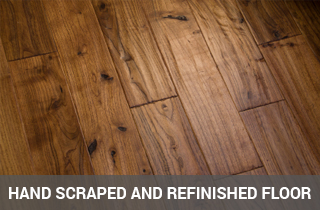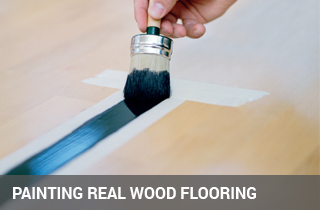Back to Flooring Products
The Different Types Of Flooring Surfaces

There are many reasons why wood flooring remains one of the most popular choices for modern homes. It is long-lasting, easy to clean, hygienic, offers excellent resale value and, most importantly, brings a sense of warmth and timeless style into any space. Beyond its durability and beauty, wooden flooring also provides something else invaluable – choice. You can choose from a wide range of wood species, grades, and installation types, but also from a variety of wood flooring surface treatments that completely change the final look and feel of your floor.
From smooth, polished surfaces to distressed and brushed textures, today’s finishing techniques allow you to customise hardwood floors to suit your interior design. Whether you’re after a rustic farmhouse charm, a contemporary minimalist vibe, or a luxurious glossy finish, there is a surface option tailored to your taste. In this guide, we explore the different types of flooring surfaces, their benefits, and how they can transform your home.
Practical Tip: When choosing a flooring surface, always consider the lifestyle of your household. Families with kids and pets often prefer brushed or textured surfaces that disguise scratches, while smooth lacquered floors are perfect for achieving a sleek, elegant look.
Brushed Wood Flooring
Brushed wood flooring is created by using a specialised wire brush to remove the softer fibres from the surface of the planks. This technique enhances the natural grain patterns of the wood, giving the floor a beautifully textured, authentic appearance. The process not only highlights the timber’s character but also makes the surface more resistant to visible scratches and everyday wear, which is why it is particularly popular for family homes and high-traffic areas.
Brushed wood floors are often paired with an oil finish, which penetrates deep into the timber, nourishing and protecting it from within while preserving a natural, organic look. The only consideration is that re-oiling will need to be carried out periodically to maintain the floor’s beauty and durability.
Luxury Tip: If you want your brushed oak or ash floor to stand out even more, consider combining the brushed texture with a white-wash or grey stain. This creates a striking, contemporary finish while keeping the durability benefits of brushed flooring.
Distressed Wood Flooring

Distressed wood flooring is designed to create a vintage, timeworn look that instantly adds character and charm to any space. Unlike perfectly sanded and flat planks, distressed floors are intentionally aged, featuring marks, dents, and imperfections that mimic the beauty of antique wood. This style is ideal for rustic interiors, farmhouse designs, or vintage-inspired homes where authenticity and texture are appreciated.
Most distressed floors are produced using machines that replicate natural ageing. While this method creates a consistent look, keen eyes can sometimes spot repeating patterns. For those who prefer a more authentic feel, hand-scraped flooring is often the preferred choice, as it avoids machine-made repetition and offers a more natural, handcrafted appearance.
Practical Tip: Distressed or hand-scraped hardwood flooring is excellent for households with kids or pets. Small scratches, dents, or scuffs blend seamlessly into the surface, making them far less noticeable compared to perfectly smooth finishes.
Hand-Scraped Wood Flooring
Hand-scraped flooring is a traditional technique that has made a strong comeback in modern interior design. The phrase “everything new is well-forgotten old” applies perfectly here. Unlike distressed wood flooring, which is usually created with machines, hand-scraped floors are crafted manually, giving each plank a unique, authentic look. This craftsmanship is reflected in a higher price point but also in the individuality and charm of the final result.
Beyond aesthetics, hand-scraped hardwood floors come with practical benefits. Thanks to their textured surface, scratches, dents, and everyday wear blend seamlessly into the natural patterns. This makes them a fantastic choice for high-traffic households with children or pets. Cleaning is also easier compared to perfectly smooth floors, as imperfections naturally camouflage small marks and scuffs.
Luxury Tip: If you want to highlight the craftsmanship of hand-scraped hardwood flooring, consider choosing a wide-plank design in darker shades such as walnut or oak. These tones enhance the rustic, artisanal appeal while adding warmth and elegance to larger spaces.
Reclaimed Wood Flooring
Reclaimed wood flooring has become one of the most desirable choices for homeowners who want a floor with character, history, and sustainability. This type of flooring is created by recovering timber from old barns, factories, and other historic buildings, then reprocessing it for modern interiors. Every plank tells a story, offering a charm and uniqueness that new hardwood simply cannot replicate.
Beyond its appearance, reclaimed flooring is known for its exceptional durability. The timber has already aged and hardened over decades, making it more stable and long-lasting than many newly harvested hardwoods. Its eco-friendly credentials are also impressive—choosing reclaimed wood helps reduce the demand for fresh logging, making it a sustainable option.
The only drawback is cost, as reclaimed wood often carries a premium price tag due to sourcing and preparation. However, for those seeking something truly unique and environmentally responsible, reclaimed floors are worth the investment.
Practical Tip: Before installing reclaimed hardwood flooring, make sure it has been properly treated and kiln-dried to remove any pests and ensure stability. Always purchase from a reputable supplier to guarantee quality.
Stained Wood Flooring
The modern flooring market offers an endless variety of wood floor stains, allowing you to achieve nearly any shade or tone you desire. From deep, dramatic colours to light and airy finishes, staining gives you the freedom to completely transform the look of your floor. However, the process is more complex than it seems—the most challenging part is often colour matching. Each wood species reacts differently to stains, meaning that achieving a precise tint often requires the expertise of a professional.
On the positive side, staining and refinishing is one of the best ways to revitalise an older or worn floor. It can hide imperfections, restore natural beauty, and give your hardwood a completely fresh look without replacing the boards. Whether you want to follow design trends or restore the original colour, stained floors provide flexibility and elegance for any interior style.
Luxury Tip: For a high-end look, consider combining custom stain blends with a matte or satin finish. This approach highlights the natural grain of the wood while adding depth and sophistication to your interior.
Painted Wood Floors

While not as popular as staining, painting hardwood floors offers a unique way to transform your space. Unlike stains, which enhance the natural grain, paint covers the surface entirely, allowing you to experiment with bold colours, geometric patterns, or even a fully customised design. The downside is durability—painted floors are more prone to chipping, cracking, and wear over time, especially in high-traffic areas. Additionally, painting can lower resale value, as not every future homeowner will appreciate the style.
However, if you don’t plan to sell your property any time soon and want to make your interior stand out, painted wood flooring can be the ultimate design statement. Think of your floor as a blank canvas—this approach lets you unleash your creativity, creating a surface that is truly one of a kind and impossible to replicate with conventional finishes.
Creative Tip: Consider using durable porch or floor paints combined with a protective polyurethane topcoat. This will extend the life of your painted floor and help preserve its vibrant look.
Fumed (Smoked) Wood Flooring
Fumed or smoked wood flooring is achieved by exposing the timber to ammonia fumes for an extended period of time. This natural chemical reaction darkens the wood, resulting in deep, dusky tones ranging from warm chocolate browns to near black. The longer the exposure, the richer and darker the colour becomes. Unlike surface staining, this process penetrates into the wood, giving it a more authentic and long-lasting colour transformation.
This style is particularly appealing in modern and luxury interiors, where darker flooring adds elegance, contrast, and a touch of sophistication. Because the colour comes from within the wood rather than a surface coating, scratches and wear are less noticeable compared to stained floors. However, as with any premium finish, smoked flooring is usually more expensive and requires skilled professionals for best results.
Luxury Tip: Pair fumed oak or walnut floors with light-coloured furniture and minimalist décor to create a striking high-end contrast that elevates your space.
Oiled Wood Floors
Oiled flooring is one of the most traditional and natural ways to finish wood. Instead of forming a protective film on the surface like lacquers or varnishes, oil penetrates deep into the wood fibres, nourishing them from within. This not only highlights the wood’s natural grain and texture but also creates a warm, organic look that feels authentic underfoot. Many homeowners choose oiled floors for their natural appearance and easy repairability.
One of the biggest advantages of oiled wood floors is that scratches or wear marks can often be spot-treated without the need to sand the entire floor. Simply reapplying oil to a damaged area usually restores its beauty. However, unlike polyurethane or lacquer finishes, oiled floors do require regular re-oiling (every 1–2 years, depending on traffic) to maintain protection and appearance. For families who prefer a soft, matte look over glossy finishes, oiled floors are a timeless and practical choice.
Practical Tip: Use a specialised wood floor oil refresher or maintenance oil between full re-oiling sessions. This will extend the lifespan of your finish and keep your floors looking rich and nourished.
Lacquered Wood Floors
Lacquered flooring is a popular choice for homeowners who want a strong, protective layer on top of their wood. Unlike oils that penetrate into the timber, lacquer creates a durable film on the surface, making it highly resistant to scratches, spills, and general wear. This makes lacquered floors especially suitable for busy households and commercial spaces where heavy foot traffic is expected.
One of the main appeals of lacquered finishes is the wide variety of sheen levels available, from ultra-matt to high-gloss. This flexibility allows you to match your floor perfectly to your interior style — whether you want a subtle natural look or a striking polished appearance. Another advantage is the low-maintenance factor; lacquered floors are easy to clean with just sweeping and occasional damp mopping, without the need for frequent re-application like oiled surfaces.
On the downside, scratches on lacquered floors are more noticeable than on oiled floors, and repairing them often requires sanding and refinishing the whole area rather than just spot-treating. Still, for homeowners looking for long-term durability with minimal upkeep, lacquered wood floors remain one of the most practical and stylish solutions.
Luxury Tip: Pair your lacquered floors with underfloor heating. The protective surface layer of lacquer works beautifully with engineered wood, giving you warmth, comfort, and a flawless finish that feels premium all year round.